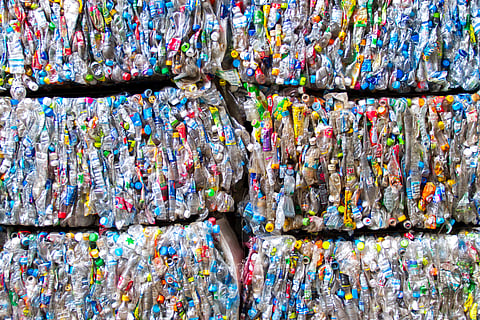On the brink of change: Why the Global Plastic Treaty must deliver now
As government delegates gather in Geneva for what could be the final round of negotiations on the Global Plastics Treaty, the air is thick with urgency. What’s at stake is not just another international agreement, but a once-in-a-generation chance to rewrite how the world produces, consumes and disposes of plastic.
The first part of the fifth session of the Intergovernmental Negotiating Committee on Plastic Pollution (INC-5.1) was held from November 25 to December 1, 2024 in Busan, Republic of Korea. The second part (INC-5.2) is taking place from August 5 to 14, 2025 in Geneva, Switzerland.
The treaty, mandated under UNEA Resolution 5/14, aims to create a legally binding instrument to end plastic pollution including in the marine environment, based on a comprehensive approach that addresses the life cycle of plastic.
While progress has been uneven across earlier rounds, INC-5.2 represents a critical point in the history of an anthropogenic world. It is here that ambition must meet agreement and commitments must crystallize into enforceable obligations.
Plastic pollution knows no borders
Plastic waste is a quintessentially transboundary issue. Carried by rivers, winds and ocean currents, it travels across borders with ease. A plastic bag discarded in one country can wash ashore thousands of kilometers away. While over 120 countries have enacted national bans on certain plastic products, the fragmented patchwork of policies has proven inadequate to stem the tide.
That’s why global bans and phase-outs of the most harmful plastic products and chemicals are not just desirable — they are essential. Harmonised global bans on carefully identified plastic products and hazardous chemicals of concern would ease enforcement burdens, reduce implementation costs and provide clarity for businesses navigating divergent regulatory environments.
The treaty must target specific plastic products that are most likely to leak into the environment and cause harm to human and ecosystem health, especially those that are single-use, non-essential or contain hazardous chemicals.
Plastics dirty little secret
Just as crucial is the need to regulate chemicals in plastics. Many widely used plastic products include additives that are carcinogenic, endocrine-disrupting, or bioaccumulative and have a tendency to break free from the polymer matrix and enter various compartments of the environment, including human bodies.
Recycling such products without addressing their toxicity perpetuates what many now call a “toxic circular economy.” The treaty must not only restrict these substances but also ensure that product design eliminates them at the source.
More importantly, developing countries in the Global South must be granted access to the knowledge, technology and safe, green chemical alternatives necessary to enable a just, equitable and inclusive transition.
Reimagining design for a “non toxic” circular future
It’s difficult to wish plastics away from our lives, but in order to be circulated across the globe, its design must change. Poorly designed plastic products thwart reuse, impede safe recycling and increase the burden on already overwhelmed waste management systems, especially in the Global South.
This is where harmonised product design criteria comes in. Backed by over 280 companies in the Business Coalition for a Global Plastics Treaty, such criteria can reduce waste, foster jobs and make recycling economically viable. They also offer clarity to manufacturers and recyclers operating across global value chains.
Financing the transition
Transforming the global plastic economy will not come cheap. Waste pickers, local authorities, small businesses and citizens, particularly in the Global South, should not be asked to shoulder the costs of systemic change. A dedicated multilateral fund, supported by developed nations and private sector contributions, is a non-negotiable requirement.
Such financial support must be accessible, predictable and responsive to country-specific needs, especially for Developing Countries, Small Island Developing States and Least Developed Countries. Currently, the source and recipients of funds and the accountability of the private sector remain largely elusive.
No data, no progress
“You can’t manage what you can’t measure,” goes the old adage and it applies perfectly here. Without reliable, transparent data on plastic production, trade and waste flows, the treaty risks being toothless. Tracking progress, enforcing commitments and holding parties accountable all hinge on data. Thus, establishing common data-reporting standards must be a cornerstone of the agreement.
Governing for the long haul
Beyond the treaty text, the machinery of implementation must be robust. That means setting up a Conference of Parties with real decision-making powers, not a body paralysed by consensus. Experience from past multilateral environmental agreements shows that when consensus becomes a weapon, ambition dies a painful death.
A “start-and-strengthen” approach beginning with enforceable commitments that build over time is widely considered both pragmatic and politically feasible. But it must come with clarity: clear initial targets, deadlines, accountability mechanisms and accessible funds.
A moment that cannot be missed
Chair, co-chairs and the secretariat now hold the responsibility of delivering an instrument that is both bold and workable. It’s a balancing act, but history shows that ambition and practicality are not mutually exclusive.
What the Montreal Protocol did for ozone, the Paris Agreement attempted for climate, this treaty must do for plastic.
Whether the negotiators succeed in Geneva will not just determine the future of plastic as a material. It will reveal whether multilateralism still has the courage to rise to the challenges of our time.
The world is watching.


